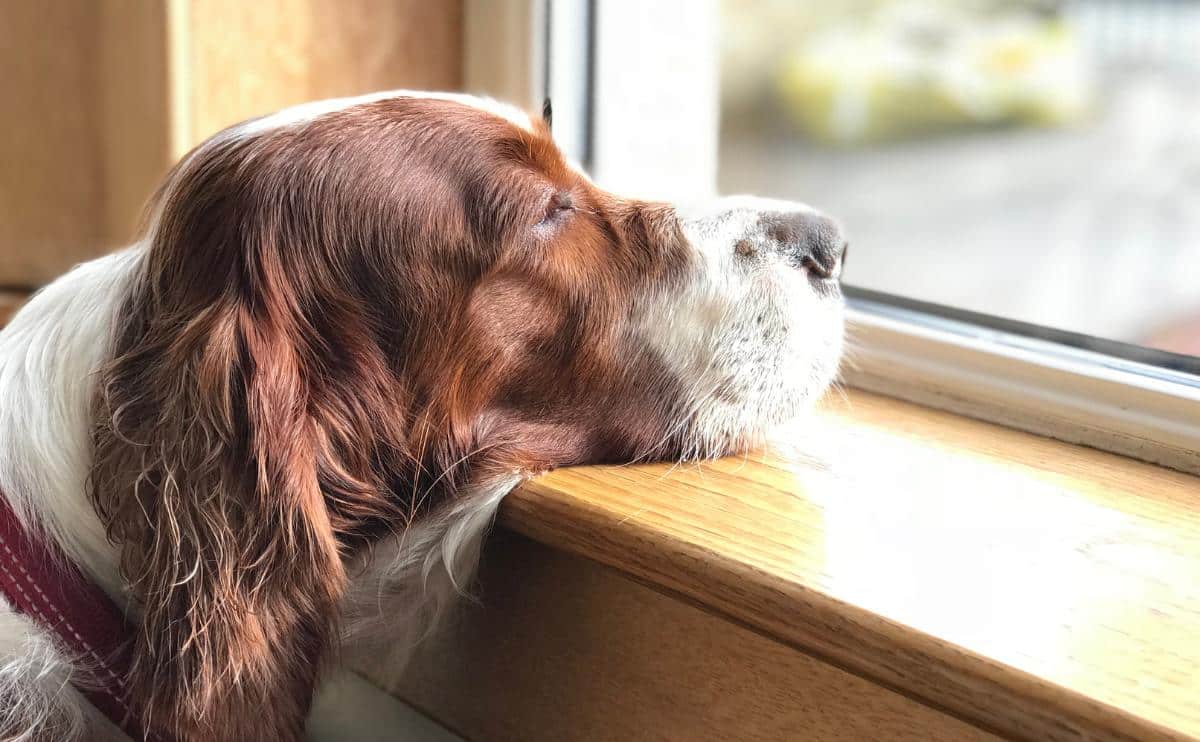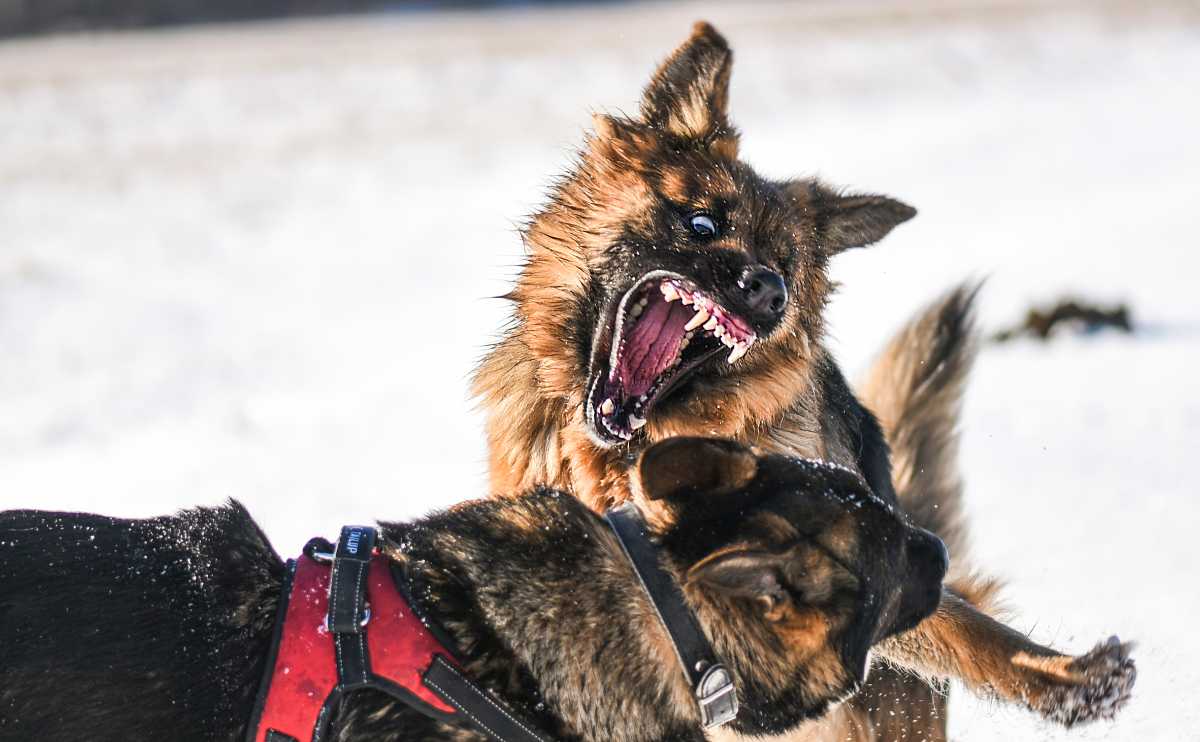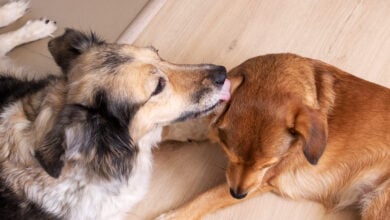I Thought My Dog Was Just Being Weird. Then I Learned Why Dogs Eat Dirt
When you purchase through links on our site, we may earn a commission. Here’s how it works.
Of all the things your dog could eat, shoes, couch cushions, mysterious sidewalk snacks, they go for dirt. Plain, flavorless, probably-pooped-on dirt. Why? Why do dogs eat dirt, and when should you worry?
Table of Contents
Some dogs treat the backyard like an all-you-can-eat buffet, shoveling soil into their mouths like it’s the secret to immortality. While a little dirt might not hurt, this odd habit can sometimes signal boredom, anxiety, or something more serious going on beneath the surface.
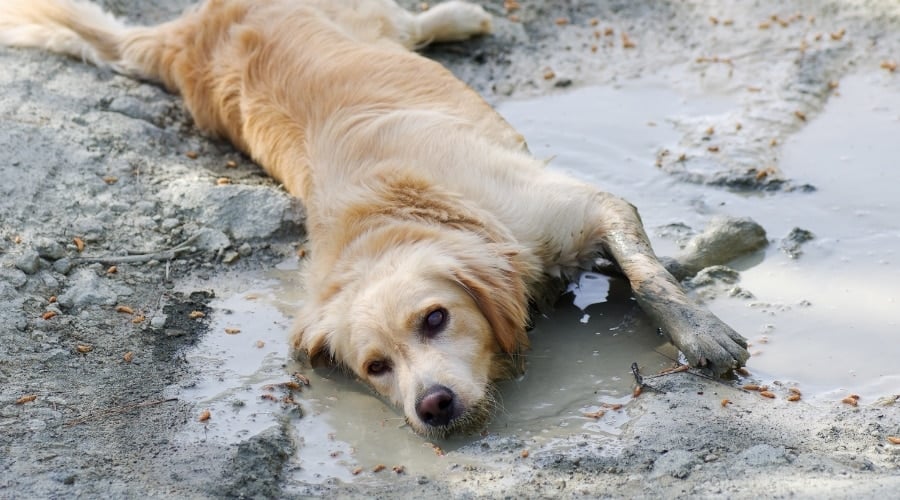
So, if your pup acts more like a backyard archaeologist than a house pet, don’t worry. We’re about to uncover what’s driving the dirt obsession, when it’s a problem, and how to stop it before your garden becomes a crime scene.
Soilmate: One Dog’s Love Affair with Eating Dirt
Before we get into the science behind dirt munching, here’s a real-life tale from one of our team members. Her pup Bear wasn’t just curious; he was committed to the dirt lifestyle. Spoiler: He was perfectly healthy… just deeply, weirdly obsessed with soil.
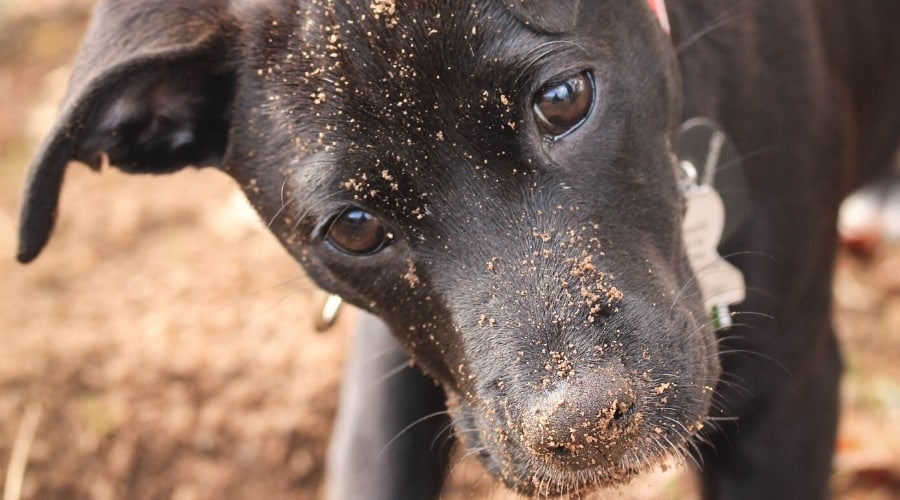
My Labrador pup Bear was not your average dirt-eater. He didn’t casually nibble on soil like a curious pup. No, Bear committed fully. He devoured dirt like it was a Michelin-starred meal.
Garden beds? Gone. Potted plants? Personal appetizers. Mulch? A crunchy topping.
I once caught him licking the edge of a flower pot with the slow intensity of someone savoring the last crumbs of chocolate cake.
At first, I panicked. Was Bear anemic? Lacking nutrients? Had he secretly read an article about detoxing with bentonite clay? We got him tested. Bloodwork, vet consults, you name it.
The results? He was in peak health. No anemia. No vitamin deficiency. Which meant one thing: Bear just really, really liked eating dirt.
There was no emotional backstory. No nutritional gap. No deep psychological wound. Just a Labrador with the culinary taste of a small goblin.
I tried to outsmart him. Enrichment toys. Long walks. Frozen peanut butter Kongs. I even fenced off parts of the yard. Bear looked at every effort like I was providing appetizers before the main course.
Bear would sprint past all of it for one glorious mouthful of soil. I once yelled, “Stop eating dirt!” he wagged his tail like I’d just told him he was a good boy.
To this day, I’m convinced Bear had a secret fantasy about becoming one with the earth. Or maybe he just liked the crunch.
– Danielle DeGroot, Rescue Dog Owner & Canine Journal Writer
Why Is My Dog Eating Dirt? These 6 Reasons Might Surprise You
Sometimes, dogs eat dirt just because it’s there. Like, right there. Convenient. Crunchy. Probably smells like raccoon pee. But if your pup keeps coming back for mouthfuls like it’s their favorite snack, it could be more than just boredom.
Here’s a breakdown of what might be going on inside your dog’s dirt-obsessed brain:
1. Nutritional Deficiencies
If your dog’s diet is missing key vitamins or minerals, they might turn to dirt in a misguided attempt to make up the difference.
Homemade meals are gaining popularity among dog owners (and we get it. Some kibble brands sound like a chemistry experiment). But even the most loving homemade dog food can fall short if it’s not formulated by a vet or canine nutritionist. This is common with dogs who eat homemade meals rather than commercial dog food or food specifically designed for a dog’s diet.
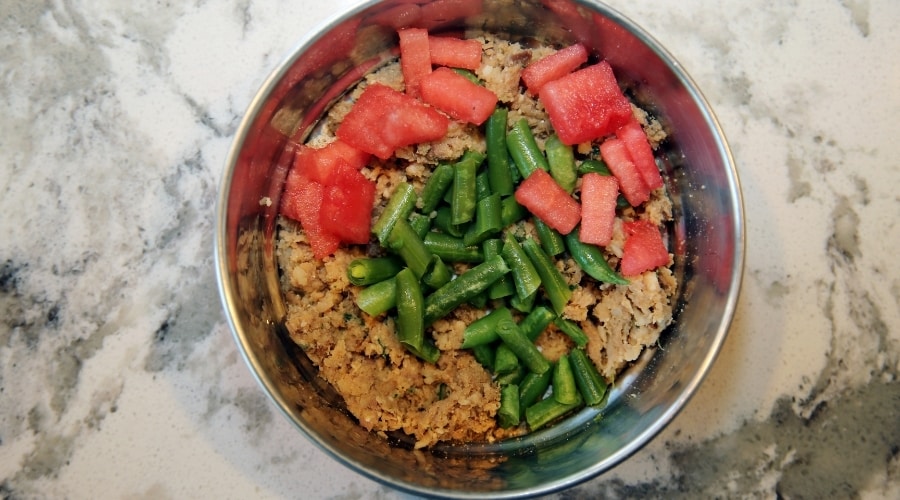
According to the Merck Veterinary Manual, balanced meals should include the right ratio of proteins, fats, vitamins, and minerals for your dog’s age, breed, and lifestyle.
Pro tip: Dirt contains trace minerals, but it’s not a reliable (or safe) multivitamin.
2. Iron Deficiency or Anemia
Dogs with anemia may crave dirt due to low iron levels, a behavior known as geophagia. This is rare but not unheard of.
Look for signs like pale gums, fatigue, heavy panting after mild activity, or loss of appetite.
If you think this may be your dog’s situation, you should have your dog evaluated by a vet or try an at-home urine test. Your vet may also want a Complete Blood Count (CBC) to check iron levels and red blood cell counts to diagnose anemia.
Note: Dirt cravings caused by anemia are instinctive, but they won’t fix the deficiency.
3. Pica (Compulsive Eating of Non-Food Items)
If your dog’s eating habits extend beyond dirt (think rocks, socks, plastic…), you may be dealing with pica.
The Merck Veterinary Manual defines pica as the chronic ingestion of nonnutritive substances, often linked to gastrointestinal diseases, liver dysfunction, or neurological issues.
It can also be behavioral, especially in high-stress or under-stimulated dogs.
If you suspect pica, talk to your vet. This isn’t just quirky; it can be dangerous.
4. Digestive Trouble
Some dogs eat dirt to calm an upset stomach, like a self-prescribed antacid.
Certain clays and soils contain kaolin or bentonite, which have mild absorbent properties and are even found in some human digestive products.
But this isn’t a safe fix. If your dog is doing this frequently, they may have a chronic digestive condition that needs attention, like inflammatory bowel disease or pancreatitis.
Bottom line: Dirt isn’t medicine. Call your vet if your dog seems uncomfortable before they DIY their treatment plan.
5. Boredom
Some dogs eat dirt because… there’s nothing else to do. Dirt is available. Dirt is chewable. Dirt is fun.
This is especially common in smart, high-energy breeds who aren’t getting enough mental stimulation.
Try rotating toys, adding puzzle feeders, brain training games, or increasing playtime and walks.
6. Anxiety or Attention-Seeking Behavior
Just like nail-biting in humans, dirt-eating in dogs can be a repetitive stress behavior.
Dogs with separation anxiety, lack of exercise, or those left alone for long periods may eat dirt as a coping mechanism or because it reliably gets your attention.
If it’s tied to stress, you might also notice pacing, whining, or destructive behaviors.
Anxiety may be to blame if the dirt habit worsens when you’re gone or gets better when you’re around.
Video: Why Do Dogs Eat Dirt?
Here’s a quick summary of why dogs eat dirt that we made to help spread the word and raise awareness about this problem.
What If My Puppy Eats Dirt?
Puppies put everything in their mouths. Socks. Slippers. The corner of your couch. And yes, dirt. If your brand-new bundle of fluff has started snacking on soil, don’t panic… yet.
Why Puppies Eat Dirt:
- Exploration: Puppies experience the world by licking, chewing, and tasting. Dirt is just one more texture to investigate.
- Teething: That gritty crunch? Apparently, it’s very satisfying for sore gums.
- Boredom or attention-seeking: Puppies figure out fast that dirt-eating gets a reaction, especially if you sprint across the yard yelling, “NOOOO!”
Puppy tip: Keep a close eye on what kind of dirt they’re drawn to. Some pups go for mulch or potting soil, which can contain dangerous cocoa, fertilizers, or mold.
How to Handle It:
- Redirect with toys or chews, especially textured ones
- Supervise outdoor time until they grow out of the soil-snacking phase
- Practice “Leave it” training early—it’ll help prevent other bad habits too
- Talk to your vet if the habit persists beyond a few weeks
Dirt eating may just be a phase. Or it might be your puppy’s secret plan to reduce you to a nervous wreck. Either way, stay calm and stay watchful.
Vet Check: When to Call in the Pros
Don’t wait it out if your dog:
- Eats dirt daily or obsessively
- Also eats other non-food items (rocks, paper, cloth)
- Shows signs of illness: vomiting, diarrhea, low energy, pale gums
- Is on a new or homemade diet that hasn’t been vet-approved
If your dog suddenly develops a compulsive behavior or shows signs of illness, a professional evaluation is the safest route.
Why Pet Insurance Is Smarter Sooner Than Later
If your dog’s sudden obsession with eating dirt has you Googling vet symptoms, it might be time to consider pet insurance. Here’s the catch: insurance only covers future issues. Anything that starts before you sign up is considered “pre-existing” and won’t be covered.
That’s why getting a policy early, while your dog is still healthy, is key. It can help cover costs like diagnostic tests, medications, and even surgery without turning your emergency fund into a ghost town. Pet insurance can be a real game-changer, whether it’s a weird appetite, a mystery illness, or just peace of mind.
Explore our guide to how pet insurance works, what it covers, and how to choose the right plan.
Is Eating Dirt Dangerous?
It depends. Eating a little bit of dirt shouldn’t be a problem. But this is only true if the dirt they’re ingesting is free of pesticides, harmful organisms, fertilizers, and other chemicals that can be harmful to them.
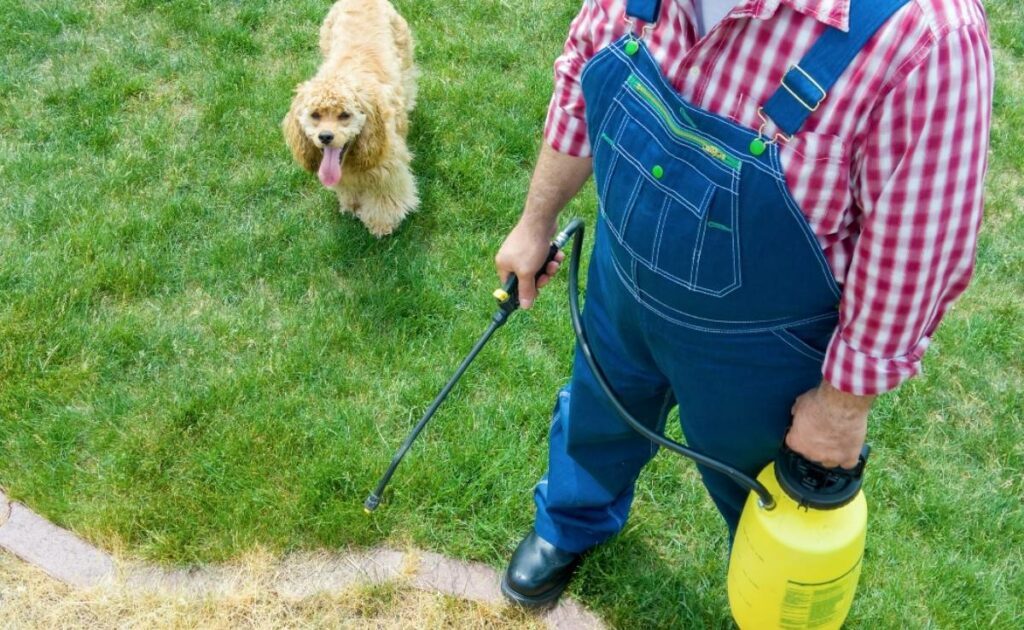
For example, if you’ve had your lawn, shrubs, or trees in your yard treated with any chemical, you must keep your dog away. Seeing your veterinarian is advised if your dog is eating dirt. Learn more about pet-safe lawn fertilizers.
Dogs Eating Dirt Isn’t Cute: Here Are 5 Ways to Stop It Fast
If your dog’s turning backyard dirt into their favorite snack, it’s time for an intervention. Here’s how to break the soil-snacking cycle before they start rating patches like a food critic.
1. Check the Scene: Is Something Tasty Hiding There?
If your dog keeps returning to the same dirt patch, there might be more to the story. Perhaps some grease drippings near your grill? Or maybe a buried bone from last summer?
Things like spilled food can make dirt smell delicious to dogs. Even another animal using your yard as a bathroom can make the dirt smell more intriguing to your dog.
Quick Tip: Do a sniff test (yep, really) and clean up any tempting leftovers or unexpected yard finds, yes, we mean poop, before letting your dog outside.
2. Burn Off the Boredom: More Walks, More Play
A tired dog is a happy dog and one with no energy to dig up your backyard. Dirt-eating can be a sign your pup needs more stimulation.
Ideas to try:
- 2 brisk walks a day
- Tug-of-war or fetch in the yard
- Dog sports or agility training
- Puzzle feeders or treat-hiding games
3. Train the Brain: Behavior Fixes That Actually Work
Give your dog a job, and suddenly, dirt isn’t so delicious. Obedience training, agility games, tricks, or even daily command drills can keep their brain busy and their snout out of the soil.
Pro Tip: Start with a strong “leave it” command. When they listen, shower them with praise, treats, or their favorite toy, whatever gets their tail wagging.
4. Interrupt the Munch Mode: Catch It, Redirect It
See your dog making a beeline for the dirt? Act fast, call their name, toss a toy, or start a quick play session. Distraction is your best friend.
Bonus: Keep a few “emergency toys” stashed in your pocket on walks.
5. Bring Out the Big Guns: When It’s Time for a Pro
If you’ve tried everything, and your dog’s still going full dirt-diver, it is time to call for a backup. A vet visit can help rule out medical issues. Once health concerns are off the table, a certified dog trainer can step in with behavior strategies that actually stick.
Red flag combo: Dirt eating + weird poop = schedule a vet visit ASAP.
How to Make Your Yard Less Tasty
- Skip cocoa mulch & bone meal: Smells great but toxic to dogs.
- Avoid chemical fertilizers: Use pet-safe options and keep dogs off treated areas.
- Check for food scraps: Grill grease or old bones can attract repeat offenders.
- Block hot spots: Use fencing or barriers around “high-risk” dirt zones.
- Try deterrent sprays: Use citrus or vet-safe products to make soil less snackable.
This Poop Color Could Mean Trouble: What Dirt-Eating Might Be Hiding
Think dirt is the weirdest thing your dog’s eating? Let’s talk poop. (Yes, seriously.) Sometimes, that backyard snacking habit is your dog’s way of self-medicating, especially if their stool throws up red flags.
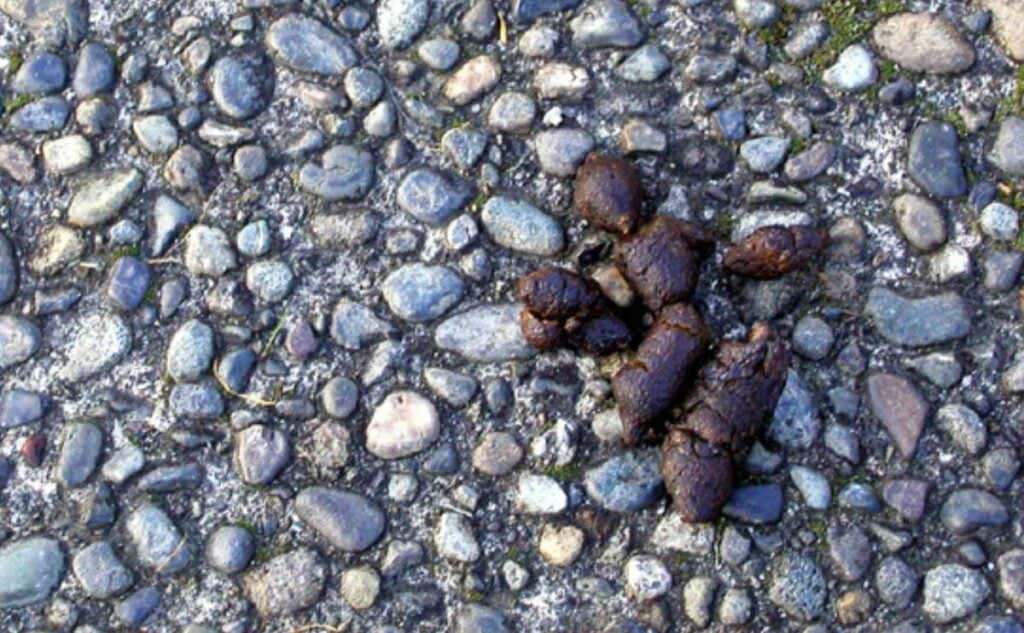
Watch out for these poop colors:
- Black or tarry: Could signal internal bleeding—time to call the vet.
- Gray or greasy: Trouble digesting fat. It may be linked to pancreas or liver issues.
- Bright yellow or orange: Liver or bile duct problems could be brewing.
- Green: It might mean your pup’s been eating grass or some kind of potentially harmful chemical.
- White spots: Possible worms. Gross and contagious.
Learn more about what your dog’s poop color means in our detailed guide.
Frequently Asked Questions About Dogs Eating Dirt
Below, we’ve answered some of the most commonly asked questions about dogs eating dirt. If you don’t see yours, let us know in the comments; we are here to help!
What should I do if my dog eats a lot of dirt suddenly?
Sudden or excessive dirt-eating may indicate a medical issue like gastrointestinal distress, pica, or a nutritional deficiency. Contact your veterinarian promptly to determine the cause.
How can I stop my dog from eating dirt on walks?
Use positive reinforcement training to redirect the behavior. Commands like “leave it” and keeping your dog engaged with treats or toys can help. A basket muzzle may be considered for chronic cases under vet advice.
Is there a difference between a dog eating dirt and eating soil or mud?
Yes, though often used interchangeably, “dirt,” “soil,” and “mud” can differ in composition. Mud may contain standing water and bacteria, while soil can include fertilizers or mulch. All can pose health risks, but mud may carry a higher risk of parasites and toxins.
Does feeding a raw diet increase the risk of dirt-eating?
Feeding a raw or homemade diet may increase the risk if it’s not properly balanced. Incomplete raw diets can lead to mineral deficiencies (e.g., calcium, zinc), which may trigger unnatural cravings like dirt. Always consult a veterinary nutritionist when formulating raw meals.
Dirt is Just the Beginning: Other Gross Things Dogs Love to Eat
If you thought dirt was the weirdest thing your dog would willingly put in their mouth, we have some bad news. Dogs are walking trash compactors with fur. They even eat their own poop at times.
From cat poop to rabbit droppings, rocks, mulch, socks, and the occasional mystery blob on the sidewalk, dogs have a knack for turning anything into a snack. Sometimes it’s boredom, sometimes it’s instinct, and sometimes… it’s just a dog being a dog.
If your pup’s dirt habit is part of a bigger trend of eating all the wrong things, it’s worth checking in with your vet. A little weirdness is normal, eating the entire backyard isn’t. Whether it’s diet, anxiety, or just good old-fashioned curiosity, getting to the root of the behavior can help your dog stay safe and keep your garden (and laundry basket) intact.
